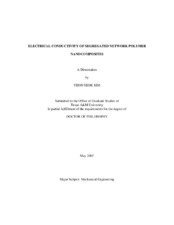| dc.contributor.advisor | Grunlan, Jaime C. | |
| dc.creator | Kim, Yeon Seok | |
| dc.date.accessioned | 2010-01-15T00:15:40Z | |
| dc.date.accessioned | 2010-01-16T02:18:34Z | |
| dc.date.available | 2010-01-15T00:15:40Z | |
| dc.date.available | 2010-01-16T02:18:34Z | |
| dc.date.created | 2007-05 | |
| dc.date.issued | 2009-06-02 | |
| dc.identifier.uri | https://hdl.handle.net/1969.1/ETD-TAMU-1880 | |
| dc.description.abstract | A set of experiments was designed and performed to gain a fundamental
understanding of various aspects of the segregated network concept. The electrical and
mechanical properties of composites made from commercial latex and carbon black are
compared with another composite made from a polymer solution. The percolation
threshold of the emulsion-based composite is nearly one order of magnitude lower than
that of the solution-based composite. The segregated network composite also shows
significant improvement in both electrical and mechanical properties with low carbon
black loading, while the solution-based composite achieves its maximum enhancement
at higher carbon black loading (~25wt%). The effect of the particle size ratio between
the polymer particle and the filler was also studied. In order to create a composite with
an extremely large particle size ratio (> 80,000), layer-by-layer assembly was used to
coat large polyethylene particles with the carbon black. Hyper-branched
polyethylenimine was covalently grafted to the surface of polyethylene to promote the
film growth. The resulting composite has a percolation threshold below 0.1 wt%, which
is the lowest percolation threshold ever reported for a carbon-filled composite. Theoretical predictions suggest that the actual percolation threshold may be lower than
0.002 wt%.
Finally, the effect of the emulsion polymer modulus on the segregated network
was studied. Monodispersed emulsions with the different glass transition temperature
were used as the matrix. The composites made using the emulsion with higher modulus
show lower percolation threshold and higher conductivity. Higher modulus causes
tighter packing of carbon black between the polymer particles. When the drying
temperature was increased to 80°C, the percolation thresholds became closer between
some systems because their moduli were very close. This work suggests modulus is a
variable that can be used to tailor percolation threshold and electrical conductivity, along
with polymer particle size. | en |
| dc.format.medium | electronic | en |
| dc.format.mimetype | application/pdf | |
| dc.language.iso | en_US | |
| dc.subject | Segregated Network | en |
| dc.subject | Carbon Black | en |
| dc.subject | Electrical Condcutivity | en |
| dc.subject | Particle Size Ratio | en |
| dc.title | Electrical conductivity of segregated network polymer nanocomposites | en |
| dc.type | Book | en |
| dc.type | Thesis | en |
| thesis.degree.department | Mechanical Engineering | en |
| thesis.degree.discipline | Mechanical Engineering | en |
| thesis.degree.grantor | Texas A&M University | en |
| thesis.degree.name | Doctor of Philosophy | en |
| thesis.degree.level | Doctoral | en |
| dc.contributor.committeeMember | Morgan, Roger J. | |
| dc.contributor.committeeMember | Ounaies, Zoubeida | |
| dc.contributor.committeeMember | Sue, Hung-Jue | |
| dc.type.genre | Electronic Dissertation | en |
| dc.type.material | text | en |
| dc.format.digitalOrigin | born digital | en |


